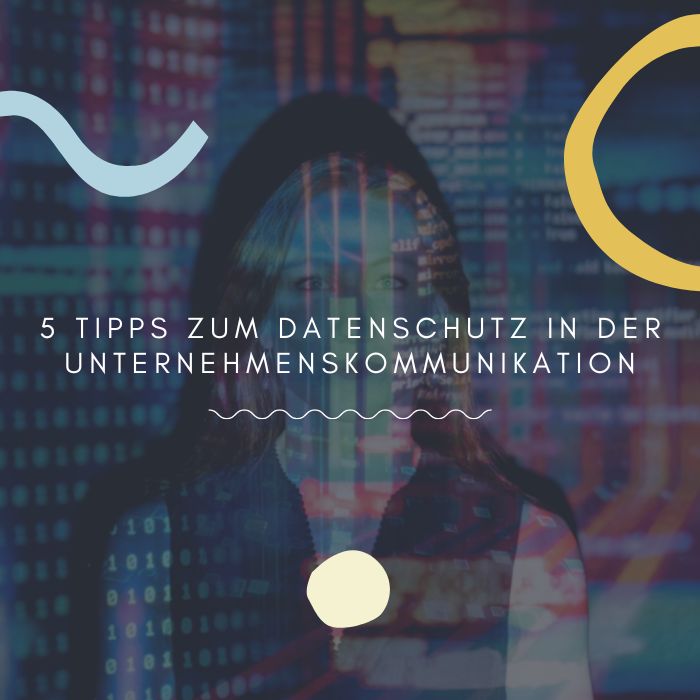How to protect personal data of customers and employees
The General Data Protection Regulation (GDPR) has been regulating the handling of personal data in both public institutions and companies since 2018. But not only the external and customer-oriented corporate communication has to be GDPR-compliant since then. Employee communication is also subject to data protection regulations, since personal data is collected, stored and transmitted via the intranet, cloud services and apps, for example. The corona pandemic and new work structures such as home office and hybrid working have also expanded the requirements for GDPR-compliant corporate communication, as new tools have been added, for example for video conferences. Read our 5 tips on how to strengthen and implement data protection in your corporate communications.
Tip 1: Train your employees on data protection
The observance of data protection rules within corporate communication requires that all employees are aware of the problem, recognize the need for GDPR-compliant communication and also observe the data protection rules during work in internal employee communication. It makes sense to train new employees, for example during onboarding, on the GDPR and the applicable data protection rules in corporate communication, if possible with a focus on the respective work area. There are already certified online training courses for this, which can be completed with a test.
Tip 2: Provide GDPR-compliant communication tools and IT applications
Prevent uncertainties and problems regarding the handling of personal data by ensuring GDPR-compliant IT applications and communication tools for internal and corporate communication. Check whether your communication platforms or webinar software comply with data protection. Check in detail whether, for example, cloud solutions for location-independent storage of files are GDPR-compliant and the servers used for this are located at least in the EU.
Many communication tools are developed or provided by US companies and therefore require careful handling of data protection. With the video conferencing tool Zoom, for example, data protection problems have repeatedly been made public in the past – if you decide to use such a tool, you must make all settings so that use by all employees is GDPR-compliant. Even messenger services such as WhatsApp can only be brought into line with the GDPR to a limited extent, for example via WhatsApp for Business. Since many employees already use messengers like WhatsApp or Telegram privately, it can happen that they are also used to communicate with colleagues or customers. It is better if you as a company provide a communication infrastructure that makes it unnecessary to use privately used communication channels with potential data protection problems for work purposes.
Fully functional trial version of Snagit
New to Snagit? Try out all the screen recording and screen video features. Edit your screenshots and hide sensitive information in images.
Try Snagit now for 15 days
Tip 3: Appoint a data protection officer
There are always new communication tools on the market. The IT applications already in use regularly renew their data protection regulations and ask us to accept them. It is difficult to always have the necessary resources to check every detail. A data protection officer in a company can provide a remedy. He can help ensure that all employees adhere to, know and apply the applicable data protection regulations – in internal and external corporate communication. A data protection officer can also undergo regular further training and guarantee that your company is up to date on data protection issues. The introduction of new IT applications, the use of new communication tools – all of this can be checked in advance by a data protection officer for the company. As a contact for employees, he can also answer questions about data protection and help with problems.
Tip 4: Regularly check your corporate communications for data protection
Every year on January 28th is European Data Protection Day. The aim of this day of action, initiated by the Council of Europe, is to sensitize all citizens to the issue of data protection. You too should regularly check and, if necessary, update all rules and work instructions on the subject of data protection and corporate communication in your company. How about doing this every year for the day of action? Take the opportunity to protect your corporate communication from unwanted accomplices and eavesdroppers. Protect your company data and the data of your customers and employees – permanently.
Tip 5: Hide sensitive data and personal information
Recordings of video calls or screenshots are often used in corporate communications. Learn to hide and redact personal information or sensitive data in such recordings. With image editing software like Snagit, you can easily hide sensitive information in an image before sharing it with co-workers or the outside world. Use video editing tools like Camtasia to blur sensitive data in a video by pixeling, masking, or blurring selected areas.
Video editing – simple, intuitive and with extensive functions
Camtasia is a professional video editing tool. Trim and crop your videos, pixelate selected areas and blur sensitive data. Get your full-featured trial now.
Try Camtasia now for 30 days
